| 311
|
CHAPTER 48
Four Siblings with Muscular Dystrophy
Lead a Program for Disabled Children

Progressive weakness. Many health and
rehabilitation workers look at muscular dystrophy as one of the more
difficult and discouraging disabilities. It tends to be familial, often
affecting brothers. It is progressive and, within current medical
knowledge, incurable. Duchenne's muscular dystrophy (the commonest type)
begins in early childhood and causes increasing muscle weakness. The child
- usually a boy - develops trouble walking, and eventually needs a
wheelchair. As the weakness progresses, his arms get too weak to push his
wheelchair or lift his hands to feed himself. Eventually, the weakness
affects his breathing and, usually in his late teens or early 20s, he
dies, often from pneumonia.
The good news. Despite all this, when given
encouragement and a supportive environment, many children with
muscular dystrophy live full and adventurous lives, even though
they may die young. In this chapter, we tell the story of a remarkable
family, the Perazas. Of their 7 children, 3 boys and one girl -
CACHITO, SÓMIMO, JUANILLO, and
DINORA - had muscular dystrophy. All were in wheelchairs
by age 10. Today, only Dinora is still alive. The boys all died in their
teens or early 20s. But, in their short lives, they did some amazing and
fulfilling things.
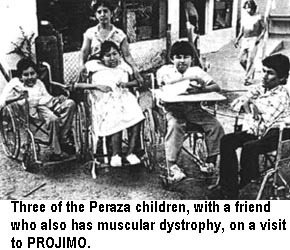
THE PERAZA FAMILY lives in a poor barrio of
Mazatlán city. When the parents realized that several of their children
had muscular dystrophy, they wanted to do all they could for them. In
those days it was impossible to get such children into the public schools.
Yet the Perazas felt that their children had the same right as other
children to attend school.
So the family created their own school. Helped by an exceptional social
worker, Teresa Paez, the Perazas met with families of other disabled
children in the community and collectively started their own education and
rehabilitation program for their children. The children themselves decided
what to name their group. They called themselves Los Pargos, the
name of a local fish which the elite consider inferior, although it
provides a good source of food and a livelihood for local fisher folk. |
| 312
|
Los Pargos

The Los Pargos school was organized as a cooperative, in which the
disabled children and parents were participating members. Most families
were quite poor. To raise money for school supplies and transport, the
families made colorful crafts to sell. Outstanding were designs with
artificial flowers, mostly made out of fish scales.
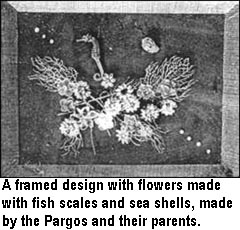
Parents and children went on work picnics to the
sea-shore where fishermen cleaned fish. They collected sackfuls of fish
scales. These they washed and sun-dried. Then they stained them various
colors and glued them together to make delicate bouquets of flowers.
With the help of Teresa Paez, Los Pargos convinced the city
government to let them use a local school building after the official
school day was over. Eventually the Education Department agreed to pay
for a teacher. But the Pargos had trouble finding a teacher who
respected and knew how to work with disabled children - until they found
Victor.
VICTOR, the teacher, was born with athetoid cerebral
palsy and began to walk when he was 8 years old. He stands and walks
with great difficulty and falls often. When excited (which he usually
is) his arms and legs jerk this way and that. He has a slight speech
problem. But Victor is avidly independent. From primary school through
college, he had to struggle to be accepted. Yet he was a gifted student.
He won a scholarship to medical school, but had to drop out because the
campus was far from home and his family could not afford bus fare. Since
then, he strove to improve his mobility. He and a friendly mechanic
invented strange and wonderful wheeled devices: walkers, motorcycles,
and even a hand-controlled auto.
Victor majored in biology and math, and has a teaching degree. For
several years he taught at the Pargos school, where he was a wonderful
example. He had loving concern for his students, yet did not pamper or
spoil them. He challenged each child to do his or her very best.
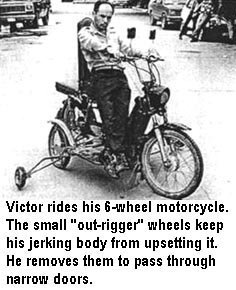
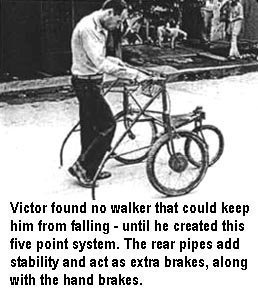

|
| 313
|
|

With a role model like Victor, many of the disabled
students became junior teachers and creative facilitators for younger
children and those who needed more assistance.
In this peer teaching process, the Peraza children took the
lead. By the time they reached their teens, their dystrophy was
advanced. Yet CACHITO and SÓSIMO, the
older two brothers, had become very capable organizers and teachers of
the Pargos. Sósimo even learned how to read and write Braille, so that
he could teach blind children. The Peraza siblings also loved to draw
and paint. With practice, they became gifted artists. One day when I
(the author) was meeting with the Pargos, Sósimo drew the pencil sketch
of me shown here.
With care and patience, the Peraza children taught other children to
draw and paint creatively. When the Pargos had enough pictures painted
and fish-scale flowers made, they periodically held a public sale.
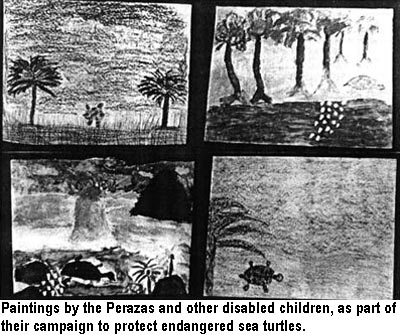
The Peraza children led Los Pargos in the defense of endangered
wildlife, with which they somehow identified. One summer, they led a
city-wide Campaign to Protect the Sea Turtles, whose
numbers were rapidly diminishing due to relentless hunting of both
turtles and eggs. The Perazas asked each Pargito (disabled
child) to do a painting of sea turtles as best as he or she could. The
resulting collection of paintings was astounding: adult turtles, turtle
eggs, and baby turtles of every size and color, swimming, dancing,
playing, laying eggs - and being hunted and butchered - in the sea and
on the beach of Mazatlán.
With the cooperation of the city authorities and local artists, a
public event was held to display the sea-turtle paintings (which sold
like hot-cakes) and to raise the awareness of the larger community. In
their defense of the sea turtles, Los Pargos won people's respect and
appreciation for the abilities of disabled children. |
| 314
|
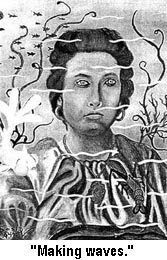
All four of the Peraza siblings became gifted artists and
craftspersons. But Sósimo was the most outstanding. Like the
other Pargitos, he had a fascination with the ocean and its
creatures. One of his most haunting paintings is the portrait of a woman
in the bottom of the ocean. After Sósimo had died, his sister Dinora
told me he had painted it "because when people die they go to the bottom
of the ocean, and that is what makes the waves."
Evolution of Los Pargos. Eventually, Los Pargos
gained enough public attention to pressure the local public schools into
accepting some less severely disabled children. Even so, many of the
Pargitos who began to attend public schools continued to come to Los
Pargos' group in the afternoons. Several of the older Pargos took over
the management, activism, and teaching responsibilities of the program.
Among these were the Peraza siblings, whose leadership skills and
ability to motivate others grew with time, even as their physical
ability and health declined.
|

This photo of Sósimo in his late teens reflects his
combination of artistic ability, self-determination, and his radiant
joy in the creative process. I wish all children with muscular
dystrophy, and their parents, could have had a chance to know and
learn from Sósimo and his family. |
As the years went by, Los
Pargos grew and expanded. Children with all kinds of disabilities -
physically disabled, mentally handicapped, epileptic, deaf, blind,
and multiply disabled - came daily from all parts of the city.
Transportation was a big problem. At last, with money they earned
plus donations by well-to-do patrons in the city, the Pargos were
able to buy a second-hand bus - which they named the Pargobus.
Periodically the Pargobus would make trips to PROJIMO, in the
village of Ajoya, about 100 miles from Mazatlán. The outings served
as visits to the countryside and a chance for the children to enjoy
the games and equipment in the Playground for All Children. The
visits also provided an opportunity for children to be fitted with
wheelchairs, orthopedic appliances, special seating, and other
assistive devices. Again, the young Perazas often played a leading
role in helping to organize these trips. It was amazing what these
four youths with muscular dystrophy managed to do, and the pride and
joy they took in doing it, even as their physical condition
gradually deteriorated.
But for all their creativity and problem-solving skills, they
could not halt the progress of the disease. Over a period of several
years, one after the other of the 3 Peraza brothers died from
pulmonary problems. Today only their sister, Dinora, is still alive.
But the dignity, caring, and leadership skills they
developed and shared with their peers live on. |
|
| 315
|
At present, Los Pargos is managed and run
by disabled graduates of the program, some of whom are continuing with
their formal schooling and some of whom have jobs. (One of the first
members of the Pargos, Miguelito, who has physical and speech
difficulties, works in an automobile repair shop, skillfully taking
dents out of damaged cars.) Occasionally, the disabled youths who run
the program call on the assistance of special educators, teachers,
doctors, and therapists when they think their help is needed. But
overall, the group takes pride in its autonomy and independence.
DINORA BECOMES AN ENGLISH TEACHER - WITH HELP FROM JOSÉ ANGEL
Recently I (the author) visited the Peraza home and had a long talk
with DINORA. She is now almost 20 years old. Her muscle
weakness has progressed so that she can not lift her arms. However, she
creates lovely hand-sewn crafts by balancing her forearms on the
armrests of her wheelchair. She still is active with Los Pargos.
Although travel by bus to the Pargos center is now too difficult for
her, she teaches English to several of the Pargitos who come to
her house.

I asked Dinora how she had learned to teach English. She said she had
studied at the ACADEMIA DE INGLES THE GOLDEN GATE, a few blocks
from her home. Her father took her there daily in her wheelchair.
"David, I wish you could meet my teacher, who runs the Academia,"
said Dinora. "He's a wonderful person. He's disabled."
"Is his name José Angel?" I guessed.
"Yes!" said Dinora. "Do you know him?"
"Years ago, when he was a boy, we took him to Shriners Hospital in
California for surgery," I replied. "I haven't seen him for years, but I
heard he was teaching English in Mazatlán."
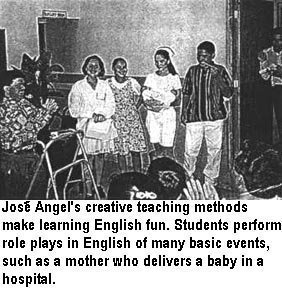
That afternoon, Dinora's father took me to visit JOSÉ ANGEL
Tirado. The Academy, next to his father's house, is a great success,
with 3 classrooms and 3 teachers. José Angel, who has a rare
degenerative bone disease, made many trips to Shriners Hospital in
California for surgery when he was a child and an adolescent. Now he has
artificial hips and knees. On his many visits to the USA he learned a
lot of English.
Once back in Mexico, José Angel began tutoring classmates in English,
and he eventually started teaching small groups. He was a good teacher
who knew how to make learning fun. More and more students wanted him to
teach them. So, his father rented a room next door, and that was the
start of the Academy. Today, there are 80 students and a long waiting
list. Financially, the Academy has been so successful that José Angel
paid for a full renovation of his father's house. He charges enough to
make a good living. But for disabled people who want to study at
the Academy, he gives full scholarships. |
| 316
|
| A close community. The
Peraza family and the Pargos, together with disabled role models and
teachers and like Victor and José Angel, form a close community of peers
and friends who help, challenge and provide inspiration to one another.
Despite their difficulties, there is an aura of warmth and even joy
about the Peraza home. Every time I visit the Peraza's, I come away with
new energy and hope - not so much hope for a wonder drug to cure
muscular dystrophy (although that would be marvelous), but rather, hope
for humanity. The Peraza family and their children with
muscular dystrophy somehow found unusual strength and vitality. The
children made the most of their lives, however short, finding pleasure
in helping others in need. We can learn a lot from them.

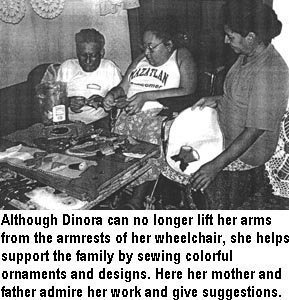
Their spirit lives on. Three of the four Peraza
children are no longer physically present. But each of them, until very
shortly before his death, found great pleasure and dignity in helping
other children in need. The remarkable abilities they developed were not
limited to their artistic creativity. They inspired disabled and
non-disabled people to do their best, and to bring out the best in one
another. Their short lives, far from being tragic, were full and
rewarding - with joys, sorrows, challenges, and adventures - as life
should be. |
| 317
|
Innovative Therapy Aids for Other Children with Muscular
Dystrophy
CHIRO and RICARDO are two brothers
with muscular dystrophy, from a village called Limón. (Child-to-Child
activities to help school children be more accepting of these boys are
described in Chapter 45, on page 300.)
When their parents brought the brothers to PROJIMO, they were at a loss
as how to help their sons. They had taken the boys to a rehabilitation
center in the city where they had been given a number of exercises to
stretch their tight heel cords and to try to maintain their muscle tone.
But the boys whined and complained when their parents tried to apply the
exercises, which were anything but fun.
At PROJIMO, Mari encouraged Jesús and some of the other disabled
children to introduce Chiro and Ricardo to different activities in the
Playground for All Children. Playing on the ramps and swings, the boys
engaged in exercises that stretched their tight heel-cords and helped
them use many muscles of their bodies. And the boys enjoyed it.
Inspired by the PROJIMO playground, the boys' father decided to build
at home some of the playground equipment that his sons most enjoyed, and
which provided necessary exercise. The following photos show some of the
equipment he built, with the help of his sons, behind the family hut in
their village.
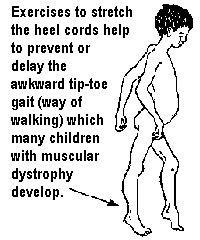
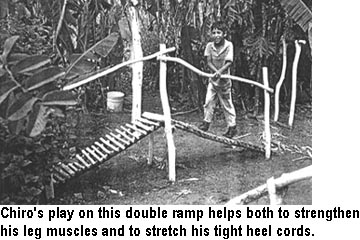 |
| 318
|
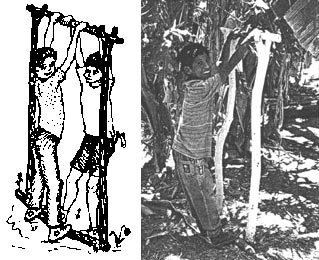
Heel-cord stretcher. This apparatus, invented by
their father, also helps Ricardo and Chiro stretch their tight heel
cords. This is done by stepping on the pole on the ground with the front
part of the foot, and then rocking back and forth.
The device also helps exercise the child's shoulders, arms and hands.

Standing with the fore-foot on the pole on the ground helps to
stretch tight heel-cords. The bend in the pole - so that it slants down
to the center from either side - helps combat inward (varus) deformities
of the feet.
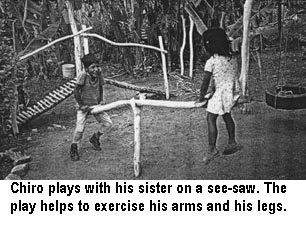
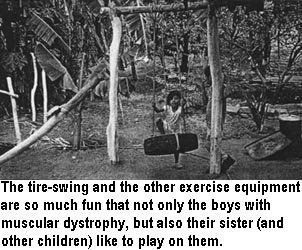
|
|